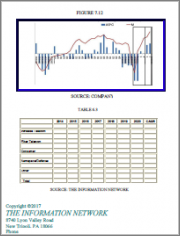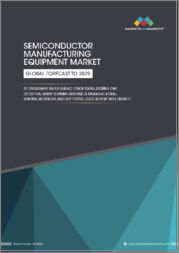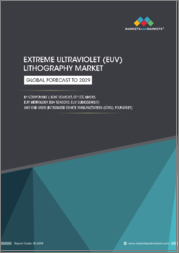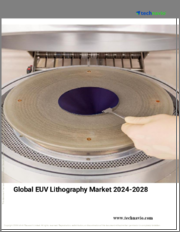
|
시장보고서
상품코드
1609176
세계의 차세대 리소그래피 재료 시장 : 유형, 기술, 최종 사용자별 예측(2025-2030년)Next-Generation Lithography Materials Market by Type, Technology, End-User - Global Forecast 2025-2030 |
||||||
차세대 리소그래피 재료 시장은 2023년에 1억 3,241만 달러로 평가되었고, 2024년에는 1억 4,862만 달러에 이를 것으로 예측되며, CAGR 17.62%로 성장하여 2030년에는 4억 1,243만 달러에 달할 것으로 예상됩니다.
차세대 리소그래피(NGL) 재료의 범위와 정의에는 마이크로 일렉트로닉스 산업의 중요한 구성 요소인 첨단 반도체와 포토닉스 제조에 사용되는 최첨단의 재료와 기술이 포함됩니다. 고속화, 고성능화의 요구가 높아지는 가운데, NGL 재료는 불가결한 것이 되고 있습니다. 수술을 가능하게 하는 데 필수적이며, 칩의 소형화와 성능 향상의 혁신을 촉진합니다. 주요 성장 요인으로는 첨단 소비자 일렉트로닉스에 대한 수요 증가, IoT 디바이스 확대, 5G 기술의 지속적인 진보 등이 있습니다. 재료 개발을 통한 제조 공정의 효율성과 비용 효율성 향상에는 많은 기회가 있습니다. 인프라 필요 이러한 과제에 직면하고 있습니다. 또한 환경 규제와 재료의 지속가능성도 큰 제약이 되고 있지만, 환경 친화적으로 지속 가능한 리소그래피 재료나, 반도체 제조의 이산화탄소 배출량을 삭감하는 방법 개발에 기술 혁신의 기회가 익숙해지고 있습니다. 추천 시장의 경쟁은 치열하고 기술의 진보와 소비자 수요에 의해 다이나믹하게 변화하고 있기 때문에 새로운 시장 기회를 활용해, 일반적인 과제를 극복하기 위해서는 지속적인 혁신과 민첩한 전략 입안이 필요합니다.
| 주요 시장 통계 | |
|---|---|
| 기준년(2023) | 1억 3,241만 달러 |
| 추정년(2024) | 1억 4,862만 달러 |
| 예측년(2030) | 4억 1,243만 달러 |
| CAGR(%) | 17.62% |
시장 역학: 급속히 진화하는 차세대 리소그래피 재료 시장의 주요 시장 인사이트 공개
차세대 리소그래피 재료 시장은 수요 및 공급의 역동적인 상호 작용에 의해 변모를 이루고 있습니다. 새로운 비즈니스 기회를 얻을 수 있습니다. 이러한 동향을 종합적으로 파악함으로써 기업은 정치적, 지리적, 기술적, 사회적, 경제적 영역에 걸친 다양한 리스크를 경감할 수 있음과 동시에 소비자 행동과 그것이 제조 비용과 구매 동향에 미치는 영향을 보다 명확하게 이해할 수 있습니다.
- 시장 성장 촉진요인
- 스마트폰이나 웨어러블 디바이스 수요 증가
- 최고 순도·고품질의 혁신적 재료를 필요로 하는 반도체 제조 업계의 성장
- 시장 성장 억제요인
- 차세대 리소그래피 재료의 가격 상승
- 시장 기회
- 첨단 기술 IoT, 빅 데이터의 차세대 리소그래피 재료에의 통합
- 리소그래피법의 진보에 의한 공정수의 삭감
- 시장의 과제
- 재료 생산의 복잡성에 따른 문제
Porter's Five Force : 차세대 리소그래피 재료 시장을 탐색하는 전략 도구
Porter's Five Force Framework는 시장 상황경쟁 구도를 이해하는 중요한 도구입니다. Porter's Five Force Framework는 기업의 경쟁력을 평가하고 전략적 기회를 탐구하는 명확한 기술을 제공합니다. 이 프레임워크는 기업이 시장 내 세력도를 평가하고 신규 사업의 수익성을 결정하는 데 도움이 됩니다. 이러한 통찰을 통해 기업은 자사의 강점을 활용하고 약점을 해결하고 잠재적인 과제를 피함으로써 보다 강인한 시장에서의 포지셔닝을 확보할 수 있습니다.
PESTLE 분석 : 차세대 리소그래피 재료 시장에서 외부로부터의 영향 파악
외부 거시 환경 요인은 차세대 리소그래피 재료 시장의 성과 역학을 형성하는데 매우 중요한 역할을 합니다. 정치적, 경제적, 사회적, 기술적, 법적, 환경적 요인 분석은 이러한 영향을 탐색하는 데 필요한 정보를 제공합니다. PESTLE 요인을 조사함으로써 기업은 잠재적인 위험과 기회를 더 잘 이해할 수 있습니다. 이 분석을 통해 기업은 규제, 소비자 선호, 경제 동향의 변화를 예측하고 앞으로 예상되는 적극적인 의사 결정을 할 준비를 할 수 있습니다.
시장 점유율 분석 : 차세대 리소그래피 재료 시장 경쟁 구도 파악
차세대 리소그래피 재료 시장의 상세한 시장 점유율 분석을 통해 공급업체의 성과를 종합적으로 평가할 수 있습니다. 기업은 수익, 고객 기반, 성장률 등 주요 지표를 비교하여 경쟁 포지셔닝을 밝힐 수 있습니다. 이 분석을 통해 시장 집중, 단편화, 통합 동향을 밝혀내고 공급업체는 경쟁이 치열해지면서 자사의 지위를 높이는 전략적 의사 결정을 내리는 데 필요한 지식을 얻을 수 있습니다.
FPNV 포지셔닝 매트릭스 : 차세대 리소그래피 재료 시장에서 공급업체의 성능 평가
FPNV 포지셔닝 매트릭스는 차세대 리소그래피 재료 시장에서 벤더를 평가하는 중요한 도구입니다. 정보를 기반으로 의사 결정을 내릴 수 있습니다. 네 가지 사분면을 통해 벤더를 명확하고 정확하게 부문화하고 전략 목표에 가장 적합한 파트너 및 솔루션을 파악할 수 있습니다.
전략 분석 및 권장 : 차세대 리소그래피 재료 시장에서 성공을 위한 길을 그리기
차세대 리소그래피 재료 시장의 전략 분석은 세계 시장에서의 프레즌스 강화를 목표로 하는 기업에 필수적인 요소입니다. 이 접근법을 통해 경쟁 구도에서 과제를 극복하고 새로운 비즈니스 기회를 활용하여 장기적인 성공을 거둘 수 있는 시스템을 구축할 수 있습니다.
이 보고서는 주요 관심 분야를 포괄하는 시장의 종합적인 분석을 제공합니다.
1. 시장 침투: 현재 시장 환경의 상세한 검토, 주요 기업의 광범위한 데이터, 시장 도달범위 및 전반적인 영향력 평가.
2. 시장 개척도: 신흥 시장의 성장 기회를 파악하고 기존 분야의 확장 가능성을 평가하며 미래 성장을 위한 전략적 로드맵을 제공합니다.
3. 시장 다양화: 최근 제품 출시, 미개척 지역, 업계의 주요 진보, 시장을 형성하는 전략적 투자를 분석합니다.
4. 경쟁 평가 및 정보 : 경쟁 구도를 철저히 분석하여 시장 점유율, 사업 전략, 제품 포트폴리오, 인증, 규제 당국 승인, 특허 동향, 주요 기업의 기술 진보 등을 검증합니다.
5. 제품 개발 및 혁신 : 미래 시장 성장을 가속할 것으로 예상되는 최첨단 기술, R&D 활동, 제품 혁신을 강조합니다.
또한 이해관계자가 충분한 정보를 얻고 의사결정을 할 수 있도록 중요한 질문에 대답하고 있습니다.
1. 현재 시장 규모와 향후 성장 예측은?
2. 최고의 투자 기회를 제공하는 제품, 부문 및 지역은 어디입니까?
3. 시장을 형성하는 주요 기술 동향과 규제의 영향은?
4. 주요 벤더의 시장 점유율과 경쟁 포지션은?
5. 벤더 시장 진입·철수 전략의 원동력이 되는 수익원과 전략적 기회는 무엇인가?
목차
제1장 서문
제2장 조사 방법
제3장 주요 요약
제4장 시장 개요
제5장 시장 인사이트
- 시장 역학
- 성장 촉진요인
- 스마트폰이나 웨어러블 디바이스 수요 증가
- 최고 순도와 품질의 혁신적인 재료를 필요로 하는 반도체 제조 산업의 성장
- 억제요인
- 차세대 리소그래피 재료의 고가격
- 기회
- 첨단 기술 IoT, 빅 데이터를 차세대 리소그래피 재료에 통합
- 프로세스 스텝을 삭감하는 리소그래피법의 진보
- 과제
- 재료 생산의 복잡성에 따른 문제
- 성장 촉진요인
- 시장 세분화 분석
- Porter's Five Forces 분석
- PESTEL 분석
- 정치적
- 경제
- 사교
- 기술적
- 법률상
- 환경
제6장 차세대 리소그래피 재료 시장 : 유형별
- 보조 재료
- 마스크 소재
- 실리콘 카바이드
- 질화 실리콘
- 감광 재료
제7장 차세대 리소그래피 재료 시장 : 기술별
- 극단 자외선 리소그래피
- 이온 프로젝션 리소그래피
- SCALPEL 투영형 전자빔 리소그래피
- X선 근접
제8장 차세대 리소그래피 재료 시장 : 최종 사용자별
- 자동차
- 가전
- IT 및 통신
제9장 아메리카의 차세대 리소그래피 재료 시장
- 아르헨티나
- 브라질
- 캐나다
- 멕시코
- 미국
제10장 아시아태평양의 차세대 리소그래피 재료 시장
- 호주
- 중국
- 인도
- 인도네시아
- 일본
- 말레이시아
- 필리핀
- 싱가포르
- 한국
- 대만
- 태국
- 베트남
제11장 유럽·중동 및 아프리카의 차세대 리소그래피 재료 시장
- 덴마크
- 이집트
- 핀란드
- 프랑스
- 독일
- 이스라엘
- 이탈리아
- 네덜란드
- 나이지리아
- 노르웨이
- 폴란드
- 카타르
- 러시아
- 사우디아라비아
- 남아프리카
- 스페인
- 스웨덴
- 스위스
- 터키
- 아랍에미리트(UAE)
- 영국
제12장 경쟁 구도
- 시장 점유율 분석 2023
- FPNV 포지셔닝 매트릭스, 2023
- 경쟁 시나리오 분석
- 전략 분석과 제안
기업 목록
- Allresist GmbH
- Avantor, Inc.
- Brewer Science, Inc.
- DJ MicroLaminates, Inc.
- Dongjin Semichem Co. Ltd.
- DuPont de Nemours, Inc.
- Fujifilm Holdings Corporation
- Irresistible Materials Ltd.
- JSR Corporation
- Kayaku Advanced Materials, Inc.
- KemLab Inc.
- Merck KGaA
- micro resist technology GmbH
- SACHEM, INC.
- Shenzhen Didao Microelectronics Technology Co., Ltd.
- Shin-Etsu Chemical Co., Ltd.
- Sumitomo Chemical Co., Ltd.
- Tokyo Ohka Kogyo Co., Ltd.
- Weifang Xingtaike Microelectronic Materials Co., Ltd.
The Next-Generation Lithography Materials Market was valued at USD 132.41 million in 2023, expected to reach USD 148.62 million in 2024, and is projected to grow at a CAGR of 17.62%, to USD 412.43 million by 2030.
The scope and definition of Next-Generation Lithography (NGL) Materials encompass cutting-edge materials and technologies used in advanced semiconductors and photonics manufacturing, a critical component of the microelectronics industry. With the escalating demand for smaller, faster, and more powerful electronic devices, NGL materials have become indispensable. These materials are essential for enabling techniques like extreme ultraviolet (EUV) lithography, nanoimprint lithography, and directed self-assembly lithography, which facilitate innovations in chip miniaturization and performance enhancement. Their application is broad, extending to sectors such as consumer electronics, automotive, telecommunications, and healthcare, where high-performance microchips are pivotal. Key growth factors include the ever-increasing demand for advanced consumer electronics, the expansion of IoT devices, and ongoing advancements in 5G technology. Opportunities abound in research and development, particularly in improving the efficiency and cost-effectiveness of manufacturing processes through the development of novel materials with improved etching resistance and resolution. However, the market faces challenges such as high R&D costs, the complexity of integrating new materials into existing fabrication processes, and the need for specialized skills and infrastructure. Additionally, environmental regulations and the sustainability of materials pose significant constraints. Nonetheless, innovation opportunities are ripe in the development of eco-friendly, sustainable lithography materials and methods that reduce the carbon footprint of semiconductor manufacturing. Businesses are advised to focus on strategic partnerships with semiconductor manufacturers and invest in R&D for pioneering materials that can meet increasingly stringent industry standards. The nature of the market is highly competitive and dynamic, driven by technological advancements and consumer demands, necessitating continuous innovation and agility in strategic planning to capitalize on emerging market opportunities and overcome prevalent challenges.
| KEY MARKET STATISTICS | |
|---|---|
| Base Year [2023] | USD 132.41 million |
| Estimated Year [2024] | USD 148.62 million |
| Forecast Year [2030] | USD 412.43 million |
| CAGR (%) | 17.62% |
Market Dynamics: Unveiling Key Market Insights in the Rapidly Evolving Next-Generation Lithography Materials Market
The Next-Generation Lithography Materials Market is undergoing transformative changes driven by a dynamic interplay of supply and demand factors. Understanding these evolving market dynamics prepares business organizations to make informed investment decisions, refine strategic decisions, and seize new opportunities. By gaining a comprehensive view of these trends, business organizations can mitigate various risks across political, geographic, technical, social, and economic domains while also gaining a clearer understanding of consumer behavior and its impact on manufacturing costs and purchasing trends.
- Market Drivers
- Increasing demand for smartphones and wearable devices
- Growing semiconductor manufacturing industry requiring innovative materials of the highest purity and quality
- Market Restraints
- High prices for next-generation lithography materials
- Market Opportunities
- Integrate advanced technologies IoT, big data to the next-generation lithography materials
- Advancements in lithography method to reduce process steps
- Market Challenges
- Problems associated with complexity in material production
Porter's Five Forces: A Strategic Tool for Navigating the Next-Generation Lithography Materials Market
Porter's five forces framework is a critical tool for understanding the competitive landscape of the Next-Generation Lithography Materials Market. It offers business organizations with a clear methodology for evaluating their competitive positioning and exploring strategic opportunities. This framework helps businesses assess the power dynamics within the market and determine the profitability of new ventures. With these insights, business organizations can leverage their strengths, address weaknesses, and avoid potential challenges, ensuring a more resilient market positioning.
PESTLE Analysis: Navigating External Influences in the Next-Generation Lithography Materials Market
External macro-environmental factors play a pivotal role in shaping the performance dynamics of the Next-Generation Lithography Materials Market. Political, Economic, Social, Technological, Legal, and Environmental factors analysis provides the necessary information to navigate these influences. By examining PESTLE factors, businesses can better understand potential risks and opportunities. This analysis enables business organizations to anticipate changes in regulations, consumer preferences, and economic trends, ensuring they are prepared to make proactive, forward-thinking decisions.
Market Share Analysis: Understanding the Competitive Landscape in the Next-Generation Lithography Materials Market
A detailed market share analysis in the Next-Generation Lithography Materials Market provides a comprehensive assessment of vendors' performance. Companies can identify their competitive positioning by comparing key metrics, including revenue, customer base, and growth rates. This analysis highlights market concentration, fragmentation, and trends in consolidation, offering vendors the insights required to make strategic decisions that enhance their position in an increasingly competitive landscape.
FPNV Positioning Matrix: Evaluating Vendors' Performance in the Next-Generation Lithography Materials Market
The Forefront, Pathfinder, Niche, Vital (FPNV) Positioning Matrix is a critical tool for evaluating vendors within the Next-Generation Lithography Materials Market. This matrix enables business organizations to make well-informed decisions that align with their goals by assessing vendors based on their business strategy and product satisfaction. The four quadrants provide a clear and precise segmentation of vendors, helping users identify the right partners and solutions that best fit their strategic objectives.
Strategy Analysis & Recommendation: Charting a Path to Success in the Next-Generation Lithography Materials Market
A strategic analysis of the Next-Generation Lithography Materials Market is essential for businesses looking to strengthen their global market presence. By reviewing key resources, capabilities, and performance indicators, business organizations can identify growth opportunities and work toward improvement. This approach helps businesses navigate challenges in the competitive landscape and ensures they are well-positioned to capitalize on newer opportunities and drive long-term success.
Key Company Profiles
The report delves into recent significant developments in the Next-Generation Lithography Materials Market, highlighting leading vendors and their innovative profiles. These include Allresist GmbH, Avantor, Inc., Brewer Science, Inc., DJ MicroLaminates, Inc., Dongjin Semichem Co. Ltd., DuPont de Nemours, Inc., Fujifilm Holdings Corporation, Irresistible Materials Ltd., JSR Corporation, Kayaku Advanced Materials, Inc., KemLab Inc., Merck KGaA, micro resist technology GmbH, SACHEM, INC., Shenzhen Didao Microelectronics Technology Co., Ltd., Shin-Etsu Chemical Co., Ltd., Sumitomo Chemical Co., Ltd., Tokyo Ohka Kogyo Co., Ltd., and Weifang Xingtaike Microelectronic Materials Co., Ltd..
Market Segmentation & Coverage
This research report categorizes the Next-Generation Lithography Materials Market to forecast the revenues and analyze trends in each of the following sub-markets:
- Based on Type, market is studied across Ancillary Material, Mask Material, and Photo-sensitive Material. The Mask Material is further studied across Silicon Carbide and Silicon Nitride.
- Based on Technology, market is studied across Extreme Ultraviolet Lithography, Ion Projection Lithography, SCALPEL Projection Electron Beam Lithography, and X-ray Proximity.
- Based on End-User, market is studied across Automotive, Consumer Electronics, and IT & Telecommunications.
- Based on Region, market is studied across Americas, Asia-Pacific, and Europe, Middle East & Africa. The Americas is further studied across Argentina, Brazil, Canada, Mexico, and United States. The United States is further studied across California, Florida, Illinois, New York, Ohio, Pennsylvania, and Texas. The Asia-Pacific is further studied across Australia, China, India, Indonesia, Japan, Malaysia, Philippines, Singapore, South Korea, Taiwan, Thailand, and Vietnam. The Europe, Middle East & Africa is further studied across Denmark, Egypt, Finland, France, Germany, Israel, Italy, Netherlands, Nigeria, Norway, Poland, Qatar, Russia, Saudi Arabia, South Africa, Spain, Sweden, Switzerland, Turkey, United Arab Emirates, and United Kingdom.
The report offers a comprehensive analysis of the market, covering key focus areas:
1. Market Penetration: A detailed review of the current market environment, including extensive data from top industry players, evaluating their market reach and overall influence.
2. Market Development: Identifies growth opportunities in emerging markets and assesses expansion potential in established sectors, providing a strategic roadmap for future growth.
3. Market Diversification: Analyzes recent product launches, untapped geographic regions, major industry advancements, and strategic investments reshaping the market.
4. Competitive Assessment & Intelligence: Provides a thorough analysis of the competitive landscape, examining market share, business strategies, product portfolios, certifications, regulatory approvals, patent trends, and technological advancements of key players.
5. Product Development & Innovation: Highlights cutting-edge technologies, R&D activities, and product innovations expected to drive future market growth.
The report also answers critical questions to aid stakeholders in making informed decisions:
1. What is the current market size, and what is the forecasted growth?
2. Which products, segments, and regions offer the best investment opportunities?
3. What are the key technology trends and regulatory influences shaping the market?
4. How do leading vendors rank in terms of market share and competitive positioning?
5. What revenue sources and strategic opportunities drive vendors' market entry or exit strategies?
Table of Contents
1. Preface
- 1.1. Objectives of the Study
- 1.2. Market Segmentation & Coverage
- 1.3. Years Considered for the Study
- 1.4. Currency & Pricing
- 1.5. Language
- 1.6. Stakeholders
2. Research Methodology
- 2.1. Define: Research Objective
- 2.2. Determine: Research Design
- 2.3. Prepare: Research Instrument
- 2.4. Collect: Data Source
- 2.5. Analyze: Data Interpretation
- 2.6. Formulate: Data Verification
- 2.7. Publish: Research Report
- 2.8. Repeat: Report Update
3. Executive Summary
4. Market Overview
5. Market Insights
- 5.1. Market Dynamics
- 5.1.1. Drivers
- 5.1.1.1. Increasing demand for smartphones and wearable devices
- 5.1.1.2. Growing semiconductor manufacturing industry requiring innovative materials of the highest purity and quality
- 5.1.2. Restraints
- 5.1.2.1. High prices for next-generation lithography materials
- 5.1.3. Opportunities
- 5.1.3.1. Integrate advanced technologies IoT, big data to the next-generation lithography materials
- 5.1.3.2. Advancements in lithography method to reduce process steps
- 5.1.4. Challenges
- 5.1.4.1. Problems associated with complexity in material production
- 5.1.1. Drivers
- 5.2. Market Segmentation Analysis
- 5.3. Porter's Five Forces Analysis
- 5.3.1. Threat of New Entrants
- 5.3.2. Threat of Substitutes
- 5.3.3. Bargaining Power of Customers
- 5.3.4. Bargaining Power of Suppliers
- 5.3.5. Industry Rivalry
- 5.4. PESTLE Analysis
- 5.4.1. Political
- 5.4.2. Economic
- 5.4.3. Social
- 5.4.4. Technological
- 5.4.5. Legal
- 5.4.6. Environmental
6. Next-Generation Lithography Materials Market, by Type
- 6.1. Introduction
- 6.2. Ancillary Material
- 6.3. Mask Material
- 6.3.1. Silicon Carbide
- 6.3.2. Silicon Nitride
- 6.4. Photo-sensitive Material
7. Next-Generation Lithography Materials Market, by Technology
- 7.1. Introduction
- 7.2. Extreme Ultraviolet Lithography
- 7.3. Ion Projection Lithography
- 7.4. SCALPEL Projection Electron Beam Lithography
- 7.5. X-ray Proximity
8. Next-Generation Lithography Materials Market, by End-User
- 8.1. Introduction
- 8.2. Automotive
- 8.3. Consumer Electronics
- 8.4. IT & Telecommunications
9. Americas Next-Generation Lithography Materials Market
- 9.1. Introduction
- 9.2. Argentina
- 9.3. Brazil
- 9.4. Canada
- 9.5. Mexico
- 9.6. United States
10. Asia-Pacific Next-Generation Lithography Materials Market
- 10.1. Introduction
- 10.2. Australia
- 10.3. China
- 10.4. India
- 10.5. Indonesia
- 10.6. Japan
- 10.7. Malaysia
- 10.8. Philippines
- 10.9. Singapore
- 10.10. South Korea
- 10.11. Taiwan
- 10.12. Thailand
- 10.13. Vietnam
11. Europe, Middle East & Africa Next-Generation Lithography Materials Market
- 11.1. Introduction
- 11.2. Denmark
- 11.3. Egypt
- 11.4. Finland
- 11.5. France
- 11.6. Germany
- 11.7. Israel
- 11.8. Italy
- 11.9. Netherlands
- 11.10. Nigeria
- 11.11. Norway
- 11.12. Poland
- 11.13. Qatar
- 11.14. Russia
- 11.15. Saudi Arabia
- 11.16. South Africa
- 11.17. Spain
- 11.18. Sweden
- 11.19. Switzerland
- 11.20. Turkey
- 11.21. United Arab Emirates
- 11.22. United Kingdom
12. Competitive Landscape
- 12.1. Market Share Analysis, 2023
- 12.2. FPNV Positioning Matrix, 2023
- 12.3. Competitive Scenario Analysis
- 12.4. Strategy Analysis & Recommendation
Companies Mentioned
- 1. Allresist GmbH
- 2. Avantor, Inc.
- 3. Brewer Science, Inc.
- 4. DJ MicroLaminates, Inc.
- 5. Dongjin Semichem Co. Ltd.
- 6. DuPont de Nemours, Inc.
- 7. Fujifilm Holdings Corporation
- 8. Irresistible Materials Ltd.
- 9. JSR Corporation
- 10. Kayaku Advanced Materials, Inc.
- 11. KemLab Inc.
- 12. Merck KGaA
- 13. micro resist technology GmbH
- 14. SACHEM, INC.
- 15. Shenzhen Didao Microelectronics Technology Co., Ltd.
- 16. Shin-Etsu Chemical Co., Ltd.
- 17. Sumitomo Chemical Co., Ltd.
- 18. Tokyo Ohka Kogyo Co., Ltd.
- 19. Weifang Xingtaike Microelectronic Materials Co., Ltd.



















